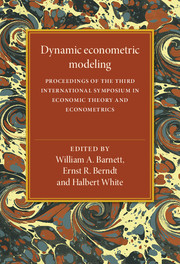 Dynamic Econometric Modeling
Dynamic Econometric Modeling Published online by Cambridge University Press: 03 May 2010
Introduction
In the last few years a growing concern over the phenomenon of the shadow (or hidden) economy has arisen, and as a consequence this topic has received increased attention among public officials, politicians, and social scientists. For the United States, like many other industrial countries, there are several important reasons why politicians and the public in general should be concerned about the growth and size of the shadow economy. Among the most important of these are:
If an increase in the size of the shadow economy is mainly caused by a rise in the tax burden, an increased tax rate may lead to a decrease in tax receipts and thus further increase the budget deficit.
If economic policy measures are based on mistaken “officially measured” indicators (such as unemployment), these measures may be at least of a wrong magnitude. In such a situation a prospering shadow economy may cause a severe problem for political decision makers because it leads to quite unreliable officially measured indicators, so that even the direction of intended policy measures may be questionable.
The rise of the shadow economy can be seen as a reaction of individuals to their overburdening by state activities (such as high taxes and an increasing number of state regulations).
To save this book to your Kindle, first ensure [email protected] is added to your Approved Personal Document E-mail List under your Personal Document Settings on the Manage Your Content and Devices page of your Amazon account. Then enter the ‘name’ part of your Kindle email address below. Find out more about saving to your Kindle.
Note you can select to save to either the @free.kindle.com or @kindle.com variations. ‘@free.kindle.com’ emails are free but can only be saved to your device when it is connected to wi-fi. ‘@kindle.com’ emails can be delivered even when you are not connected to wi-fi, but note that service fees apply.
Find out more about the Kindle Personal Document Service.
To save content items to your account, please confirm that you agree to abide by our usage policies. If this is the first time you use this feature, you will be asked to authorise Cambridge Core to connect with your account. Find out more about saving content to Dropbox.
To save content items to your account, please confirm that you agree to abide by our usage policies. If this is the first time you use this feature, you will be asked to authorise Cambridge Core to connect with your account. Find out more about saving content to Google Drive.